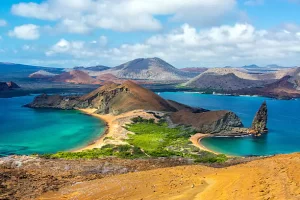The Galápagos Islands are a breathtaking archipelago located in the Pacific Ocean, renowned for their unparalleled biodiversity and as the inspiration for Charles Darwin’s theory of evolution. A trip to these islands offers a once-in-a-lifetime opportunity to experience pristine landscapes, unique wildlife, and ecological wonders.
Essential Information
- Location: Approximately 1,000 km (620 miles) off the coast of Ecuador.
- Language: Spanish.
- Currency: U.S. Dollar (USD).
- Climate: Warm and dry from June to December; wet and humid from January to May.
- Best Time to Visit: Year-round, with December to May offering warmer waters and June to November providing excellent wildlife activity.
- Entry Requirements: Visitors need a Transit Control Card ($20) and must pay a $100 park entry fee upon arrival.
Interesting Facts
- Unique Ecosystem: The Galápagos Islands are home to species found nowhere else on Earth, including giant tortoises and marine iguanas.
- Protected Status: Over 97% of the islands’ land area is part of the Galápagos National Park.
- World Heritage Site: Declared a UNESCO World Heritage Site in 1978.
- Equatorial Location: Despite their position on the equator, the islands’ climate is influenced by the Humboldt and Cromwell currents.
How to Get There
- Fly to Ecuador:
- International flights arrive at Quito (Mariscal Sucre International Airport) or Guayaquil (José Joaquín de Olmedo International Airport).
- Fly to the Galápagos:
- Flights to Baltra (Seymour Airport) or San Cristóbal Island operate daily from Quito and Guayaquil.
- Entry Requirements:
- Travelers must register with the Galápagos Transit Control System and show proof of a return ticket and hotel bookings or cruise itinerary.
Best Things to Do
- Wildlife Encounters:
- Snorkel with sea lions, turtles, and reef sharks, or observe blue-footed boobies and flightless cormorants.
- Explore Islands:
- Visit Santa Cruz Island for the Charles Darwin Research Station or hike Sierra Negra Volcano on Isabela Island.
- Scuba Diving:
- Explore underwater life at Wolf and Darwin Islands, famed for hammerhead sharks and manta rays.
- Cruise the Archipelago:
- A multi-day cruise offers access to remote islands and diverse ecosystems.
- Beaches:
- Relax at pristine beaches like Tortuga Bay or Gardner Bay.
Best Accommodation
- Luxury:
- Pikaia Lodge (Santa Cruz): A luxury eco-lodge with stunning views and first-class amenities.
- Mid-Range:
- Hotel Solymar (Santa Cruz): Offers comfortable accommodations and waterfront dining.
- Budget:
- Hostal Galapagos Morning Glory (San Cristóbal): An affordable option with excellent reviews.
Good Attractions
- Charles Darwin Research Station (Santa Cruz):
- Learn about conservation programs and see giant tortoises up close.
- El Chato Tortoise Reserve (Santa Cruz):
- Observe giant tortoises in their natural habitat.
- Kicker Rock (San Cristóbal):
- A premier snorkeling and diving spot.
- Los Tuneles (Isabela):
- Explore lava formations and see unique marine life.
- Bartolomé Island:
- Famous for its iconic Pinnacle Rock and spectacular views.
Getting Around
- Island Hopping:
- Use ferries or speedboats to travel between main islands.
- Taxis:
- Local taxis (often pickup trucks) are common for short distances.
- Guided Tours:
- Many activities require certified guides for environmental preservation.
- Rental Bikes:
- Available for exploring towns like Puerto Ayora.
Day Trips
- Santa Fe Island:
- Known for its unique species of land iguanas and snorkeling spots.
- Seymour Island:
- A haven for frigatebirds, land iguanas, and sea lions.
- Floreana Island:
- Visit the historic Post Office Bay and enjoy diving at Devil’s Crown.
Practical Tips
- Respect Wildlife: Keep a safe distance from animals and avoid touching them.
- Travel Insurance: Essential for activities like scuba diving and remote travel.
- Pack Wisely: Bring reef-safe sunscreen, lightweight clothing, water shoes, and a reusable water bottle.
- Permits: Arrange guided tours in advance as independent travel is limited in protected areas.
- Seasickness: Pack remedies if you’re prone to seasickness, especially for ferry rides.
Conclusion
The Galápagos Islands are a magical destination that promises unforgettable adventures, unique wildlife encounters, and pristine natural beauty. Whether you’re snorkeling with sea lions, hiking volcanic trails, or marveling at rare bird species, this archipelago is a haven for eco-tourists and nature lovers. Plan your trip carefully, respect the fragile environment, and get ready for a journey into one of the world’s most extraordinary ecosystems!

